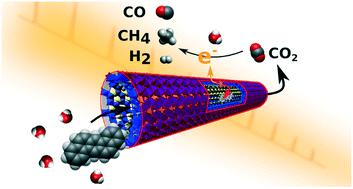当前位置:
X-MOL 学术
›
Environ. Sci.: Nano
›
论文详情
Our official English website, www.x-mol.net, welcomes your feedback! (Note: you will need to create a separate account there.)
Inorganic nanotubes with permanent wall polarization as dual photo-reactors for wastewater treatment with simultaneous fuel production
Environmental Science: Nano ( IF 7.3 ) Pub Date : 2021-07-19 , DOI: 10.1039/d1en00405k Sabyasachi Patra 1, 2, 3, 4, 5 , Delphine Schaming 3, 6, 7, 8, 9 , Pierre Picot 1, 2, 3, 4, 5 , Marie-Claire Pignié 1, 2, 3, 4, 5 , Jean-Blaise Brubach 9, 10, 11, 12 , Lorette Sicard 3, 6, 7, 8, 9 , Sophie Le Caër 1, 2, 3, 4, 5 , Antoine Thill 1, 2, 3, 4, 5
Environmental Science: Nano ( IF 7.3 ) Pub Date : 2021-07-19 , DOI: 10.1039/d1en00405k Sabyasachi Patra 1, 2, 3, 4, 5 , Delphine Schaming 3, 6, 7, 8, 9 , Pierre Picot 1, 2, 3, 4, 5 , Marie-Claire Pignié 1, 2, 3, 4, 5 , Jean-Blaise Brubach 9, 10, 11, 12 , Lorette Sicard 3, 6, 7, 8, 9 , Sophie Le Caër 1, 2, 3, 4, 5 , Antoine Thill 1, 2, 3, 4, 5
Affiliation

|
Photocatalytic production of fuels, even in small quantities, from the mineralization of hazardous pollutants, is a promising and renewable way of recycling wastewater. In the present work, the potential of methyl functionalized inorganic aluminosilicate nanotubes (methyl imogolite/Imo-CH3) as photocatalytic nanoreactors for this application is demonstrated. Using the phototoxic polycyclic aromatic hydrocarbon dibenzo(a,h)anthracene (DBAN) as a model pollutant, we show that DBAN molecules can be efficiently trapped inside Imo-CH3 nanotubes in an aqueous medium to undergo subsequent oxidative photo-degradation under UV light. The kinetics of this photo-degradation were shown to depend strongly on both the initial DBAN concentration in the nanotubes and the presence/absence of dissolved dioxygen. The photo-degradation process followed a complex mechanistic pathway, consisting of combined photo-oxidation and photo-cycloaddition reactions, where detection of carbon dioxide (CO2) as a photo-oxidation product confirmed the mineralization of encapsulated DBAN. CO and CH4 molecules were also formed, however these could arise from the further photo-reduction of CO2 on the external surface of the nanotubes. Moreover, dihydrogen (H2) was produced upon UV illumination under anaerobic conditions due to water reduction reactions on the external surfaces of Imo-CH3 nanotubes. The possible mechanistic pathways of these processes are proposed, and the dual capability of Imo-CH3 nanotubes for simultaneous pollutant degradation and H2 production is then demonstrated – a rare feat for a single photocatalyst material.
中文翻译:

具有永久壁极化的无机纳米管作为双光反应器用于同时生产燃料的废水处理
从有害污染物的矿化中光催化生产燃料,即使是少量的燃料,也是一种很有前景的可再生废水回收方式。在目前的工作中,证明了甲基官能化无机铝硅酸盐纳米管(甲基伊莫缟石/Imo-CH 3)作为该应用的光催化纳米反应器的潜力。使用具有光毒性的多环芳烃二苯并 ( a , h )蒽 (DBAN) 作为模型污染物,我们表明 DBAN 分子可以有效地捕获在 Imo-CH 3 中纳米管在水性介质中在紫外光下进行随后的氧化光降解。这种光降解的动力学强烈依赖于纳米管中的初始 DBAN 浓度和溶解的分子氧的存在/不存在。光降解过程遵循复杂的机制途径,包括组合的光氧化和光环加成反应,其中检测到二氧化碳 (CO 2 ) 作为光氧化产物证实了封装 DBAN 的矿化。还形成了CO 和 CH 4分子,但是这些可能是由于纳米管外表面上CO 2的进一步光还原而产生的。此外,二氢(H 2由于 Imo-CH 3纳米管外表面上的水还原反应,在厌氧条件下通过紫外线照射产生。提出了这些过程的可能机制途径,然后证明了 Imo-CH 3纳米管同时降解污染物和产生 H 2的双重能力——这是单一光催化剂材料的罕见壮举。
更新日期:2021-07-26
中文翻译:

具有永久壁极化的无机纳米管作为双光反应器用于同时生产燃料的废水处理
从有害污染物的矿化中光催化生产燃料,即使是少量的燃料,也是一种很有前景的可再生废水回收方式。在目前的工作中,证明了甲基官能化无机铝硅酸盐纳米管(甲基伊莫缟石/Imo-CH 3)作为该应用的光催化纳米反应器的潜力。使用具有光毒性的多环芳烃二苯并 ( a , h )蒽 (DBAN) 作为模型污染物,我们表明 DBAN 分子可以有效地捕获在 Imo-CH 3 中纳米管在水性介质中在紫外光下进行随后的氧化光降解。这种光降解的动力学强烈依赖于纳米管中的初始 DBAN 浓度和溶解的分子氧的存在/不存在。光降解过程遵循复杂的机制途径,包括组合的光氧化和光环加成反应,其中检测到二氧化碳 (CO 2 ) 作为光氧化产物证实了封装 DBAN 的矿化。还形成了CO 和 CH 4分子,但是这些可能是由于纳米管外表面上CO 2的进一步光还原而产生的。此外,二氢(H 2由于 Imo-CH 3纳米管外表面上的水还原反应,在厌氧条件下通过紫外线照射产生。提出了这些过程的可能机制途径,然后证明了 Imo-CH 3纳米管同时降解污染物和产生 H 2的双重能力——这是单一光催化剂材料的罕见壮举。



























 京公网安备 11010802027423号
京公网安备 11010802027423号